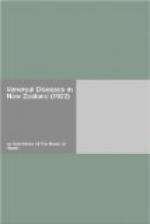At a general meeting of the Australasian Medical Congress held in Melbourne in October, 1908, it was resolved that the executive be recommended to appoint a committee to investigate and report on the facts in regard to syphilis. Such a committee was appointed, and reported to the Congress in Sydney in 1911. In 1914 the Congress was held in Auckland, and a special committee which had been appointed, with the Hon. Dr. W.E. Collins, M.L.C., as chairman, presented a valuable report giving some interesting information in regard to the prevalence of venereal disease, in New Zealand. The committee recommended that syphilis be declared a notifiable disease; that notification be encouraged and discretionary, but not compulsory; and that the Chief Medical Officer of Health be the only person to whom the notification be made. They also recommended the provision of laboratories for the diagnosis of syphilis, and that free treatment for syphilis be provided in the public hospitals and dispensaries. These recommendations were embodied in the report adopted by the Congress.
In February of the present year an important Conference, convened by the Prime Minister of Australia, was held in Parliament House, Melbourne. It was attended by official representatives of the Health Departments of all the States, together with representatives from the British Medical Association, the Women’s Medical Staff at the Queen Victoria Hospital Diseases Clinic in Melbourne, and other scientific and medical authorities. The Commonwealth subsidizes the work of the States in combating venereal disease, and the object of the Prime Minister in calling the Conference was in order that it might inquire into the effectiveness of the present system of legislation, of administrative measures, and of clinical methods, with a view of determining whether the best results were being obtained for the expenditure of the money.
Western Australia has an Act, which came into operation in June, 1916, providing for what is known as conditional notification of patients, together with other provisions for the control of venereal disease which are on a more comprehensive scale than has been attempted anywhere with the possible exception of Denmark. In December, 1916, Victoria passed a similar Act, and this example was followed by Queensland, Tasmania, and New South Wales.
The Conference, answering the several questions put to it, found that a greater proportion of persons infected with venereal disease were receiving more effective treatment than before the passing of the Venereal Diseases Act. In the opinion of the Conference this was due partly to the passing of legislation and partly to the opening of clinics affording greater opportunities for free treatment. They considered the operations of the Act had been more successful in bringing men under treatment than it had been in the case of women. Among the opinions expressed by the committee were the following: The Act was not equally successful in respect of private and hospital patients in regard to notification, but was equally successful in respect of securing to both more effective treatment. There has been an apparent reduction in the prevalence of venereal diseases, and the Conference were strongly of opinion that the results so far justify the continuance of these Acts in operation.




